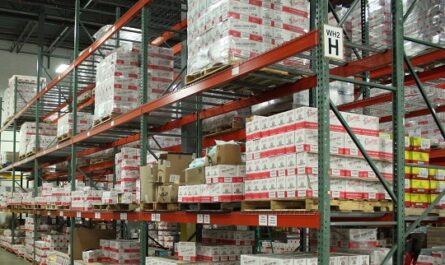In manufacturing, change happens all the time. Whether it’s to make products better, safer, or cheaper, design tweaks are common.
But switching from old materials to new ones can be tricky. It’s a crucial step that needs careful handling to avoid disrupting production and keeping things running smoothly.
That’s where smart warehouse management comes in to play – it’s all about making sure everything transitions smoothly without causing any hiccups in the production line.
Before we go further into this topic, don’t forget to follow my LinkedIn account. You’ll get more helpful insights on supply chain management there.
Table of Contents
Understanding the Challenge
When changing material specifications, a big problem is accidentally using old materials instead of new ones. This happens because the warehouse inventory doesn’t always match the new specifications.
Sometimes, it’s okay to use up the old materials slowly, but in important cases like safety concerns, switching right away is crucial.
To handle this, it’s important to communicate clearly, keep track of inventory in real-time, and decide which materials to use first.
Working together with different teams and suppliers helps make the switch smoother and avoids delays in production.
Also, teaching warehouse staff about the importance of using the right materials helps keep everything running smoothly and safely.
By doing these things, companies can handle material specification changes better and make sure their products are safe and high-quality.
Effective Strategies for Transition Management
To handle this tricky situation and make the change smooth, we need to plan ahead and take action early. Here are some important things to do.
Clear Communication Channels
Good communication is really important when we’re changing material specifications. We need to make sure everyone, like the design, procurement, and warehouse teams, is talking to each other clearly.

This helps us all work together smoothly and deal with any problems that come up. It’s also crucial to tell everyone about any upcoming changes as soon as possible.
This way, everyone can get ready, and we can avoid any issues with managing our inventory.
By keeping everyone informed and talking regularly, we can work better together and make sure everything goes well during the transition.
Real-Time Inventory Monitoring
Having a strong inventory system that tracks materials in real-time is super important when we’re changing material specifications. It helps us keep accurate records of what we have in stock and what the new specifications are.
With this system, we can easily spot any old materials and make sure we’re using the right ones. This way, we can avoid any problems with quality or not following the new specifications.
Also, this system helps us switch from old materials to new ones smoothly. We can see how much of the new materials we have and plan when to use them.
By keeping track of everything in real-time, we can make sure the transition goes smoothly across the whole production line.
Overall, having a good inventory system helps us adapt quickly to changes in material specifications and keeps our operations running smoothly.
You might also like:
- 10 Strategies to Overcome Data Processing Challenges for Supply Chain Teams Lacking Expertise
- 10 Strategies to Succeed in Supply Chain without Formal Education
Prioritization Protocols
Creating rules for using new materials is really important to make sure our products are safe and follow the rules. We need to have clear guidelines so we know which materials to use first, especially when safety is a big concern.
These rules should consider things like safety requirements and industry standards to make sure our products meet all the necessary rules and regulations.
Klik dan dapatkan ebook dari scmguide.com ini!
"47 Kesalahan Umum yang Tidak Disadari dalam Manajemen Inventory"
Manfaat yang Anda Peroleh:
🔍 Insight tentang kesalahan yang sering terabaikan
🔧 Tips dan trik praktis untuk perbaikan
📚 Bahasa sederhana yang mudah dipahami

By following these rules, we can make the change to new materials smoothly and avoid any problems with production.
Having these rules also helps us manage the change to new materials better. We can make decisions faster and use our resources wisely.
This way, we can avoid using old materials by mistake and make sure our products are up to date with the latest safety and quality standards.
Overall, having clear rules for using new materials is super important for keeping our products safe and following all the rules during the transition.
Training and Awareness Programs
Training warehouse staff is really important to make sure they understand why it’s crucial to use the right materials during changes.
These training sessions should teach them why material specifications change and how it affects things like product quality, safety, and following the rules.
With this knowledge, staff can see why it’s so important to use the new materials correctly and how it helps keep everything running smoothly.
Also, the training should give practical tips on how to tell if materials are old or new and what to do if there are any problems.
Creating a culture where warehouse staff know they’re responsible for using the right materials helps prevent mistakes during changes.
Companies should encourage staff to talk openly about any concerns they have and make sure they feel comfortable asking questions about material specifications.
When staff feel responsible for using the right materials, they’re more likely to help prevent errors and find ways to improve the transition process.
Overall, with the right training and a supportive culture, warehouse staff can make sure the transition to new materials goes well and everything stays safe and follows the rules.
Cross-Functional Collaboration
Working together between different departments is really important when we’re changing material specifications.
When teams like design, procurement, quality control, and warehouse management come together, they can use their different skills and ideas to make a plan for the change.

By talking and working together, these teams can agree on what needs to happen and when, making sure everyone is on the same page.
This helps make the transition go smoothly because everyone knows what they need to do and when.
Having regular meetings is also a big help to make sure everyone keeps working together during the change.
These meetings give teams a chance to talk about how things are going, share any problems they’ve found, and make changes to the plan if needed.
By talking openly and solving problems together, teams can make sure the change to new materials happens without any big issues.
Overall, when teams work together and have regular meetings, it helps the transition to new materials happen smoothly and everyone stays focused on their part in making it successful.
You might also like:
- The Domino Effect: Unraveling 10 Consequences of a Weak Supply Chain Team
- Mastering Inventory Audits: A Comprehensive 10-Step Guide for Success
Supplier Engagement
Working closely with suppliers is really important to make sure they follow the rules for the new materials and deliver them on time.
By talking openly with suppliers about the changes, we can make sure everyone understands what needs to happen.
This helps us make sure the materials they provide meet the new specifications and are good quality.
Also, by working closely with suppliers, we can use their knowledge and skills to meet our needs and make sure everything goes smoothly.
Having clear rules for when materials need to be delivered is also a big help to keep things running smoothly.
By telling suppliers exactly what we need and when we need it, we can make sure they prioritize making and delivering the right materials.
This helps us avoid any delays and keeps everything moving smoothly.

Plus, by talking openly with suppliers, we can quickly solve any problems that come up and keep things on track.
Overall, by working closely with suppliers and having clear rules for delivery, we can make sure the change to new materials happens without any big problems.
Risk Assessment
Before making changes to materials, it’s really important to look at all the possible risks. This means checking for anything that could cause problems during the change.
By looking at things like how much inventory we have, if our suppliers can handle the changes, and any rules we need to follow, we can figure out what might go wrong and how to fix it.
This helps us be ready for any challenges that might come up and make sure everything goes smoothly.
Having a backup plan is also a big help to deal with any unexpected problems. This plan has different ways to fix problems quickly, like finding new suppliers or changing our production schedule.
By having these plans in place, we can handle any issues that come up and keep things running smoothly.
Overall, by looking at risks and having backup plans, we can make sure the change to new materials happens without any big problems.
Conclusion
To sum up, making sure materials change smoothly in the warehouse needs a lot of different things to happen.
This includes talking clearly, keeping track of inventory in real-time, deciding what materials to use first, training staff, working together with different teams, talking with suppliers, and looking at risks.
By doing all of these things, companies can handle the change confidently and make sure products keep coming out smoothly, while still being safe and good quality.
Overall, using smart warehouse management practices is really important to succeed in the changing world of manufacturing.
I hope you find it helpful!
Please share this article with your colleagues so they can also benefit. For more insights on supply chain management, follow my LinkedIn account. You’re free to use all articles on this blog for any purpose, even for commercial use, without needing to give credit.

 by
by 


